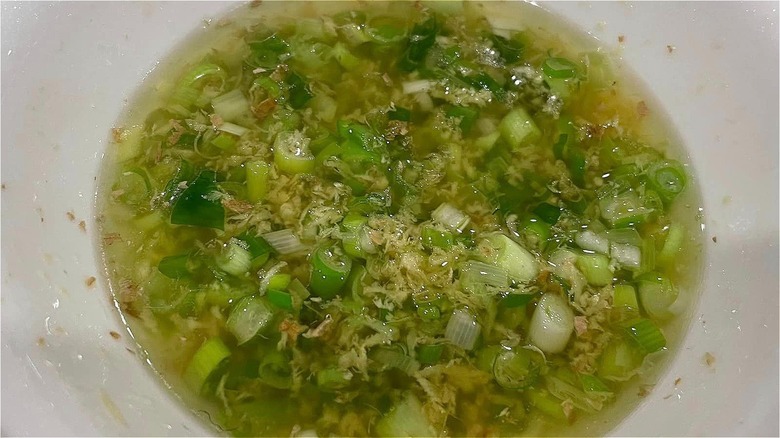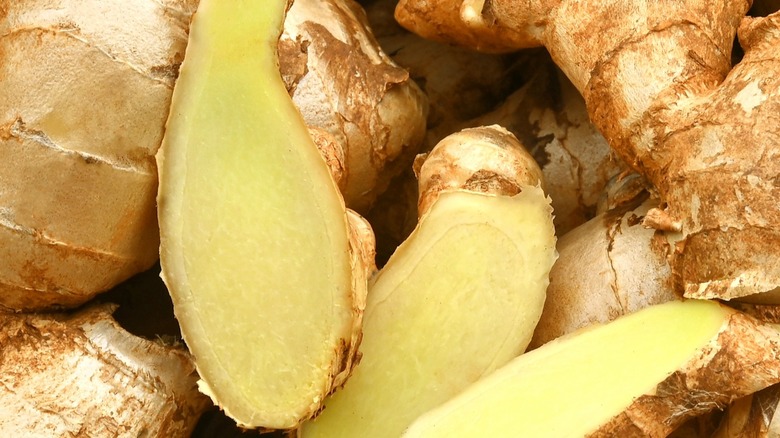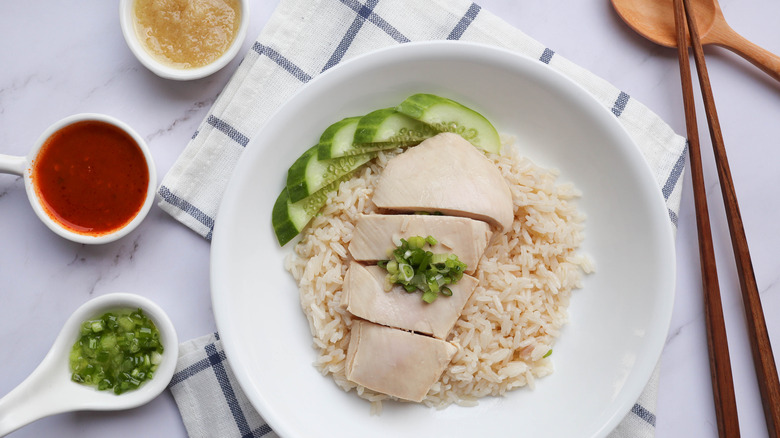Ginger Scallion Sauce Is A Versatile Chinese Condiment
Condiment people are all or nothing. Amid the great Sriracha shortage of 2023, spice fiends were shelling out $50 a bottle online to make sure they could still get their red rooster fix, for example. There is another mildly spicy Asian condiment that you can whip up at home in five minutes. You don't need a secret formula or any strange ingredients, either. This condiment can last for weeks in the fridge, although it usually doesn't survive that long without getting eaten. This spectacular condiment is ginger scallion sauce (姜葱酱) and if you're looking for a new condiment obsession, it is a very sensible choice!
Ginger scallion sauce, like all of the great Asian condiments, strikes a seemingly impossible balance. On one hand, it is light and tangy, capable of cutting through the unctuousness of pork shoulder or adding zest to plain chicken. On the other hand, it's an oily, savory flavor bomb that can add depth, piquancy, and richness to plain noodles or an unseasoned broth. In other words — you're going to want to put this sauce on everything!
How to make ginger scallion sauce
The basic ingredients in ginger scallion sauce include ginger root, scallions, and a neutral oil for a base. Chefs deploy their highest-rated chef's knives in preparing this sauce as crushing scallions can give them a slimy texture.
All ginger scallion sauces include a neutral oil with a high smoke point. Some cooks will also add dark toasted sesame oil for added nuttiness, but only at the end, as this delicate oil tends to lose its flavor when exposed to high heat. Examples of neutral oils with a high smoke point include canola oil, corn oil, and vegetable oil.
A high smoke point is important, because to make ginger scallion sauce the authentic way you need to get oil as hot as possible without burning it. Going past an oil's smoke point can cause the oil to develop acrid flavors and even harmful cancer-causing chemicals, so it's important not to heat oils much beyond the temperature where they start to shimmer. This superheated oil is poured over the fresh aromatics in a process known as blooming or tempering, which both brings out the flavor of the ingredients and helps infuse that flavor throughout the oil itself.
What really finishes this sauce is the seasoning. A teaspoon of light soy sauce adds saltiness and umami, while a dash of vinegar cuts the oil and salt to let the ginger's tanginess sing. While a fresh sauce tastes great, this is a sauce that only gets better after resting.
The cultural history of ginger scallion sauce
The simplicity of ginger scallion sauce makes it hard to pin down, historically speaking. The traditional home of this type of condiment is in the areas around the Gulf of Tonkin and the Pearl River Delta – i.e., southern China, Hainan, and Vietnam. In Vietnamese food, Mỡ Hành, literally "onion oil," is a ubiquitous savory condiment you'll find covering clams and grilled pork dishes.
Traveling into China, you begin to see the addition of ginger and more seasonings. This is especially the case in Hainan, whose signature dish, Hainanese Chicken Rice, is often served with ginger scallion sauce. Hainanese Chicken Rice bears some similarities to "white cut chicken," a poached chicken dish that is served at Cantonese celebrations throughout southern China.
Ginger scallion sauce's introduction to the United States' culinary zeitgeist came just like Brussels sprouts and cold fried chicken, when culinary legend David Chang decided to put it on the menu at Momofuku. Ginger scallion sauce was served alongside Bo Ssäm and remains on the menu today (5) in the form of ginger scallion noodles. This is noodle-obsessive Chang's tribute to the place that introduced many New Yorkers to the delights of ginger scallion sauce, the $6.95 lo mein with ginger and scallions at Great N.Y. Noodletown in Manhattan's Chinatown.


